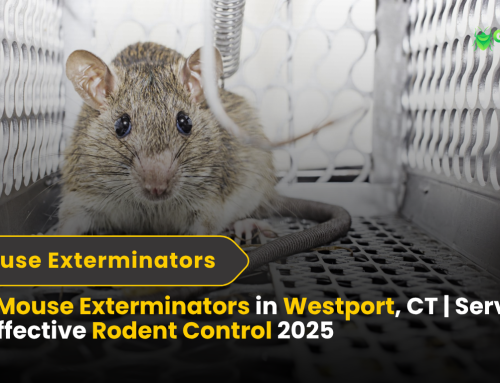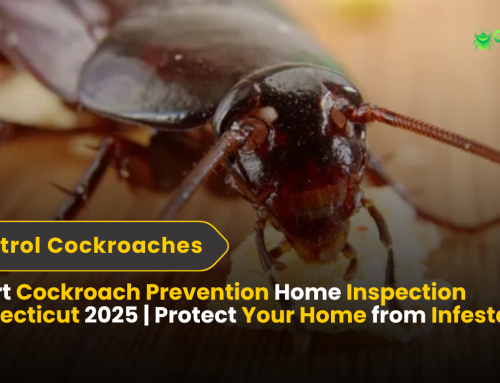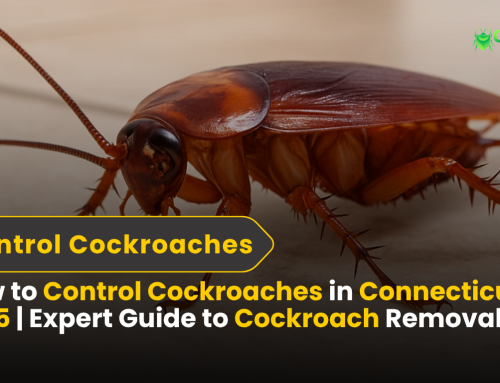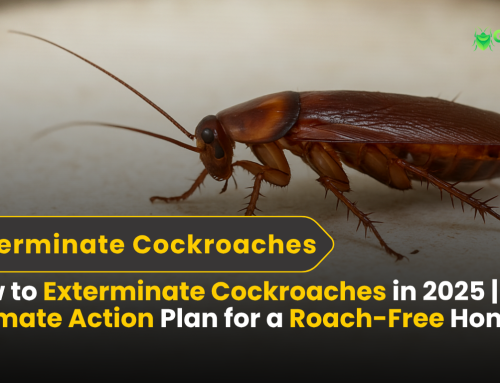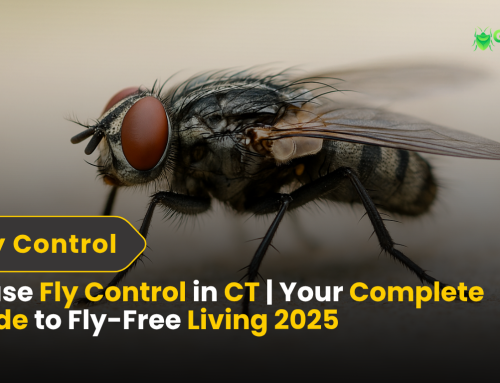How to Get Rid of Flies in 2025 | Proven Methods for Indoor & Outdoor Fly Control in CT
If you’ve noticed flies buzzing around your kitchen or backyard, you’re not alone. These persistent pests are one of the most common nuisances for homeowners in Connecticut, especially in warmer months. Whether it’s house flies, fruit flies, or cluster flies, they can spread bacteria, contaminate food, and make outdoor spaces unbearable.
In this complete guide, we’ll show you how to get rid of flies effectively — indoors and outdoors — using proven methods, natural remedies, and professional solutions.
At Green Pest Management CT, we specialize in fly control in CT, helping homeowners in Greenwich, Stamford, Darien, Westport, Wilton, and New Canaan enjoy cleaner, pest-free homes and yards all year long.
Why Do Flies Invade Homes and Yards in Connecticut?
Before jumping into fly removal, it’s important to understand why they appear in the first place.
Common Causes of Fly Infestations
| Source | Description | Prevention Tip |
|---|---|---|
| Food Waste | Flies breed near garbage, compost, or pet food. | Seal bins tightly & remove trash daily. |
| Moisture | Damp drains, soil, or leaks attract flies. | Fix leaks & maintain dry surfaces. |
| Organic Matter | Decaying leaves, animal droppings, or manure. | Regularly clean outdoor areas. |
| Light & Warmth | Flies are drawn to light and warmth indoors. | Use screens and keep doors closed. |
Pro Tip:
In Fairfield County, CT, fly activity spikes during June to September when humidity rises. Scheduling a professional inspection in early spring can prevent infestations before they start.
How to Get Rid of Flies Indoors
Indoor fly infestations can be frustrating and unhygienic, especially in kitchens and bathrooms. Let’s break down how to handle flies removal effectively inside your home.
Step 1 — Identify the Type of Fly
Different fly species require different treatment methods.
| Type of Fly | Appearance | Common Locations | Control Method |
|---|---|---|---|
| House Fly | Gray, ¼ inch, red eyes | Kitchens, windows | Sanitation + traps |
| Fruit Fly | Tiny, brown, red eyes | Near ripe fruit or drains | Vinegar traps |
| Drain Fly | Fuzzy, moth-like | Sinks, bathrooms | Drain cleaning |
| Cluster Fly | Larger, sluggish | Attics, windows | Vacuum + exclusion |
Tip: If you notice sluggish, dark flies near windows in winter, they’re likely cluster flies, common in older Connecticut homes.
Step 2 — Eliminate Attractants
-
Clean spills, crumbs, and pet food daily.
-
Empty trash bins regularly.
-
Store food in airtight containers.
-
Rinse recyclables before placing them in bins.
-
Keep drains clean using baking soda + vinegar weekly.
Even small traces of sugar or protein can attract hundreds of flies within days.
Step 3 — Use DIY Fly Removal Methods
Apple Cider Vinegar Trap
-
Fill a small bowl with apple cider vinegar.
-
Add a few drops of dish soap.
-
Cover loosely with plastic wrap and poke small holes.
-
Flies enter but can’t escape.
Essential Oil Repellents
Flies dislike strong scents such as:
-
Lavender oil
-
Peppermint oil
-
Eucalyptus oil
Add 10 drops to a spray bottle with water and mist window frames and doorways.
UV Light Traps
Modern UV fly traps attract and kill flies silently — perfect for kitchens or commercial spaces like restaurants in Stamford or Greenwich.
Step 4 — Apply Safe Indoor Fly Control Sprays
Use low-toxicity or EPA-approved insect sprays designed for indoor use. Avoid heavy chemicals around pets or food.
Recommended placement:
-
Under sinks
-
Behind appliances
-
Around windows and entryways
If the problem persists, a professional indoor fly treatment from Green Pest Management CT ensures lasting results without harming your family or pets.
How to Get Rid of Flies Outdoors — Effective Yard & Garden Fly Control
Outdoor fly infestations often begin near garbage bins, compost piles, or pet waste areas. For outdoor fly control, it’s crucial to disrupt breeding sites and create an environment that flies avoid.
Step 1 — Maintain a Clean Yard
Flies thrive in decay. Keep your yard tidy with these habits:
-
Remove grass clippings and fallen fruit.
-
Pick up pet waste daily.
-
Keep trash cans sealed and clean.
-
Avoid overwatering plants (standing water attracts flies).
Pro Tip:
CT homeowners in Wilton and New Canaan often notice spikes in fly activity after lawn fertilization or composting. Cover compost bins tightly and avoid raw food scraps.
Step 2 — Install Outdoor Fly Traps and Baits
There are several effective outdoor trap options:
| Type | How It Works | Ideal Use |
|---|---|---|
| Disposable Fly Bags | Attracts flies with scent bait | Hang 20–30 ft away from patios |
| Electric Zappers | Kills flies instantly using UV light | Near decks or outdoor kitchens |
| Bait Stations | Lures house flies & stable flies | Barns, fences, garbage areas |
Place traps away from living spaces so they attract flies away from you, not toward your guests.
Step 3 — Use Natural Repellents in Gardens
Certain plants naturally deter flies. Plant these around patios or garden beds:
-
Basil
-
Mint
-
Marigold
-
Lavender
You can also make a DIY herbal fly spray using a mix of basil and lemongrass oil diluted in water.
Step 4 — Apply Outdoor Sprays & Treatments
For large yards or repeated infestations, consider a professional outdoor treatment plan.
Green Pest Management CT uses eco-friendly fly control products that target breeding areas while keeping pollinators safe.
These treatments are ideal for:
-
Residential lawns
-
Outdoor dining areas
-
Farm or equestrian properties
They’re particularly helpful in rural Fairfield County towns where humidity and vegetation increase fly populations.
Step 5 — Manage Drainage & Moisture
Poor drainage creates damp breeding zones. Inspect these areas:
-
Gutters
-
Lawn edges
-
Compost bins
-
Pet bowls
Keeping your property dry significantly reduces the fly population.
Step 6 — Schedule Preventive Treatments
For long-term relief, schedule seasonal fly control in CT.
Spring and early summer are ideal times for preventive sprays to break breeding cycles before flies peak.
Call Green Pest Management CT early in the season to customize your yard treatment plan.
Natural & Eco-Friendly Fly Removal Remedies
If you’re looking for natural fly removal solutions that are safe for pets, children, and the environment, you’re in luck. Many homeowners across Connecticut towns like Greenwich, Wilton, and Westport prefer eco-friendly pest control. These solutions are just as effective when used consistently.
Below are the top natural methods trusted by both homeowners and eco-conscious pest professionals.
1. Homemade Fly Repellent Sprays
Make your own all-natural fly spray at home:
Ingredients:
-
2 cups water
-
10 drops of lavender oil
-
5 drops of eucalyptus or peppermint oil
-
1 tsp white vinegar
Instructions:
-
Mix in a spray bottle.
-
Shake well before each use.
-
Spray window sills, doorways, and trash bin areas daily.
Why it works: The essential oils act as natural deterrents, while vinegar neutralizes organic odors that attract flies.
2. Vinegar and Dish Soap Trap (Fruit Fly Favorite)
A Connecticut kitchen staple for quick fly removal:
-
Pour apple cider vinegar into a shallow bowl.
-
Add a drop of dish soap.
-
Leave it uncovered near fruit bowls or drains.
Flies are drawn to the vinegar but trapped by the soap film.
3. Natural Fly-Repelling Plants for Yards & Patios
Create a fly-repelling garden border using plants that deter flies naturally.
| Plant | Benefit | Where to Plant |
|---|---|---|
| Basil | Repels flies & mosquitoes | Around patios & doorways |
| Marigold | Releases scent flies dislike | Garden beds or entryways |
| Lavender | Fragrance deters multiple insects | Along walkways |
| Mint | Multi-pest deterrent | Potted near outdoor tables |
Pro Tip: Crush basil or mint leaves gently to release oils before guests arrive for outdoor events.
4. Lemon & Clove Fly Repellent Trick
This old-fashioned remedy works surprisingly well — especially in dining areas or during outdoor gatherings.
How to Use:
-
Cut a lemon in half.
-
Press 6–8 whole cloves into each half.
-
Place on tables or windowsills.
The citrus-clove scent combination deters house flies for hours.
5. DIY Fly Repellent Candle
Combine natural oils like citronella, lemongrass, and lavender to make your own candles. Perfect for patios in Stamford or Darien during summer evenings.
These candles release vapors that flies avoid, reducing the number that come near outdoor dining areas.
6. Safe Biological Control (Advanced Option)
For farms or compost-heavy properties in Connecticut’s rural areas, consider biological control with fly predators — tiny parasitic wasps that naturally eliminate fly larvae.
They’re non-stinging, eco-safe, and reduce populations before adult flies emerge. Professional pest control providers like Green Pest Management CT can advise if this method suits your property.
Identifying Common Fly Species in Connecticut
Understanding which type of fly you’re dealing with helps select the most effective treatment. Connecticut’s mix of coastal humidity and suburban greenery makes it ideal habitat for several species.
| Fly Type | Appearance | Season | Common Locations | Treatment Focus |
|---|---|---|---|---|
| House Fly (Musca domestica) | Gray, red eyes | Spring–Fall | Kitchens, windows | Sanitation + traps |
| Fruit Fly (Drosophila spp.) | Tiny, tan, red eyes | Year-round | Near fruit & drains | Vinegar traps |
| Cluster Fly (Pollenia rudis) | Larger, sluggish | Fall–Winter | Attics, windows | Sealing entry points |
| Drain Fly (Psychodidae) | Fuzzy wings | Year-round | Bathrooms, drains | Drain cleaning |
| Stable Fly | Looks like house fly, bites | Summer | Lawns, barns | Outdoor sprays |
Pro Insight:
Cluster flies are particularly common in older homes across New Canaan and Darien — they often overwinter in attics and walls, then reappear in spring.
Prevention — How to Keep Flies Away Permanently
You can eliminate flies temporarily, but lasting control requires fly prevention strategies that make your property less inviting year-round.
1. Prioritize Cleanliness & Sanitation
Cleanliness is the foundation of fly prevention.
Focus Areas:
-
Kitchen counters and floors
-
Pet feeding zones
-
Garbage and compost areas
-
Outdoor grills and decks
Checklist for Daily Maintenance:
- Empty trash bins regularly
- Clean food residue after every meal
- Wipe counters with disinfectant
- Keep sinks dry overnight
2. Seal Entry Points
Small gaps and torn window screens are open invitations.
Inspect and fix:
-
Window and door seals
-
Gaps under doors
-
Attic vents and chimneys
-
Torn mesh screens
Add door sweeps and window screens if missing.
3. Improve Airflow
Flies dislike moving air. Use fans in kitchens and patios — this simple method disrupts their flight patterns.
💡 CT Homeowner Tip: Ceiling or oscillating fans in screened porches (popular in Greenwich and Westport) help deter flies naturally during summer.
4. Manage Outdoor Lighting
Flies and other insects are drawn to light. Use yellow-tinted LED bulbs in outdoor fixtures to minimize attraction.
If possible, place lights away from doors and seating areas.
5. Maintain Lawn and Landscaping
Overgrown lawns and mulch beds can harbor organic debris.
Best Practices:
-
Mow weekly in warm months.
-
Turn mulch periodically to dry it out.
-
Avoid overwatering shaded areas.
-
Keep compost bins elevated and sealed.
6. Schedule Professional Preventive Treatments
Even with diligent maintenance, flies can reappear seasonally. Partnering with Green Pest Management CT ensures:
-
Regular inspections
-
Eco-friendly outdoor treatments
-
Long-term preventive strategies
They tailor solutions for your property size, location, and environment, whether it’s a suburban home in Stamford or a rural estate in Wilton.
DIY vs Professional Fly Control — Which Is Right for You?
| Comparison Point | DIY Fly Control | Professional Fly Control |
|---|---|---|
| Cost | Low initial cost | Higher upfront but long-lasting |
| Effectiveness | Works for mild infestations | Eliminates severe infestations |
| Safety | Varies by product | Expert use of safe treatments |
| Time Commitment | Requires regular effort | Hands-off, efficient |
| Long-Term Results | Temporary | Guaranteed & monitored |
Summary:
DIY methods work well for prevention or minor infestations. But if you’re dealing with recurring flies — especially in multiple rooms or around outdoor waste areas — it’s time to call Connecticut’s trusted professionals.
Schedule your inspection with Green Pest Management CT to get personalized solutions.
Case Study: Outdoor Fly Problem Solved in Stamford, CT
Client: Residential homeowner, Stamford, CT
Issue: Persistent outdoor flies around patio and garbage bins during summer
Findings: Exposed trash bins, overwatered plants, and food residue near grill
Actions Taken:
-
Sealed and relocated trash area 25 ft away.
-
Installed outdoor fly bait traps and zappers.
-
Applied eco-safe perimeter spray.
-
Recommended natural repellent plants (basil, marigold).
Result:
Within 10 days, fly activity dropped by 90%, and maintenance visits now keep the area fly-free year-round.
Regional Considerations for Fly Control in CT
Each town in Connecticut has slightly different environmental conditions that affect fly populations.
| Town | Primary Fly Issue | Recommended Action |
|---|---|---|
| Greenwich | High humidity, coastal breezes | Regular yard sprays & screens |
| Stamford | Dense population, trash accumulation | Monthly sanitation + traps |
| Darien | Shaded properties, gardens | Natural repellents & pruning |
| Westport | Waterfront homes | Drain cleaning & bait traps |
| Wilton | Rural, animal waste areas | Biological control & sprays |
| New Canaan | Large lawns & compost | Seasonal preventive treatments |
Local Insight:
Because of CT’s humid summers and shaded neighborhoods, outdoor fly control is often the deciding factor for long-term success.
Long-Term Fly Prevention Strategies for Connecticut Homes
If you’ve followed the DIY and natural methods above, you’re already several steps ahead. But for lasting fly control, homeowners across Greenwich, Stamford, and Westport, CT must implement a layered prevention strategy that works year-round.
These strategies integrate seasonal maintenance, environmental adjustments, and professional monitoring — ensuring that flies don’t return.
1. Schedule Routine Inspections
Even minor sanitation issues or unnoticed leaks can attract flies. Routine inspections by a licensed pest control company in Connecticut like Green Pest Management CT ensure problems are detected early.
What professionals check:
-
Garbage storage areas
-
Entry points (windows, vents, basements)
-
Drain buildup or organic matter
-
Lawn compost and mulch zones
2. Manage Moisture Levels Indoors & Outdoors
Flies breed in damp environments. Regularly inspect these moisture-prone areas:
Inside:
-
Under sinks and refrigerators
-
Bathroom drains
-
Dishwasher seals
Outside:
-
Gutters and downspouts
-
Birdbaths and pet bowls
-
Lawn overwatering
Tip: Using a dehumidifier in basements can help prevent cluster fly infestations during Connecticut’s humid months.
3. Rotate Outdoor Waste Areas
Move outdoor waste bins or compost piles away from house structures. Flies can smell decaying matter from over 200 feet away.
Pro Tip:
Install tight-fitting lids and rinse bins weekly. You can even sprinkle baking soda or lime powder inside to absorb odor.
4. Maintain Year-Round Landscaping
Strategic landscaping helps control both fly breeding and entry opportunities.
Do this seasonally:
-
Trim vegetation near windows and patios.
-
Avoid standing water in plant saucers.
-
Use gravel or rock mulch instead of organic mulch near doorways.
5. Implement Integrated Pest Management (IPM)
Connecticut’s best pest management firms — like Green Pest Management CT — follow an IPM approach, combining multiple strategies for safe, eco-friendly pest control:
| IPM Element | Description | Example |
|---|---|---|
| Inspection | Identify fly species & source | Spot drain flies near sinks |
| Exclusion | Seal potential entry points | Install door sweeps & mesh |
| Sanitation | Remove attractants | Clean trash & organic waste |
| Mechanical Control | Physical traps or UV lights | Fly zappers in garages |
| Biological Control | Natural predators | Fly parasitoids on farms |
Seasonal Fly Control Checklist for Connecticut
Keeping flies away requires adjusting your approach as Connecticut’s seasons change.
| Season | Fly Activity Level | Key Prevention Tasks |
|---|---|---|
| Spring | Rising | Inspect windows, start traps, clean drains |
| Summer | Peak | Increase garbage pick-up frequency, add outdoor repellents |
| Fall | Moderate | Seal gaps, attic inspection, compost management |
| Winter | Low | Inspect for cluster flies, store repellents properly |
Local Note: Cluster flies are most active in fall and early winter in Connecticut. Prevent them by sealing attic vents and applying perimeter treatments before the first frost.
Professional Fly Control in CT — What to Expect
Sometimes, even after every DIY attempt, flies return. That’s when it’s time to call in experts who understand local conditions and species behavior.
When you hire Green Pest Management CT, here’s what to expect:
Step 1 – Detailed Inspection & Identification
Professionals identify:
-
Type of fly (house, drain, cluster, or fruit)
-
Breeding sites
-
Sanitation or moisture sources
Step 2 – Customized Treatment Plan
You’ll receive a treatment plan combining mechanical traps, targeted sprays, and sanitation advice.
These treatments use low-toxicity, eco-conscious materials — safe for pets and children.
Step 3 – Follow-Up & Prevention Guidance
After initial treatment, the team provides a follow-up visit and shares preventive maintenance tips to ensure long-term results.
Ready to act? Schedule your professional fly inspection today with Green Pest Management CT — serving Greenwich, Darien, Stamford, Wilton, Westport, and all surrounding towns.
When Should You Call a Fly Exterminator in CT?
Flies are easy to underestimate until they multiply rapidly. Here’s how to know when professional help is necessary:
Signs You Need a Fly Exterminator:
-
You see clusters of flies near windows or light fixtures.
-
DIY traps only work temporarily.
-
You find maggots near drains or garbage bins.
-
Odors persist even after cleaning.
-
You operate a business (restaurant, daycare, healthcare facility) where sanitation is critical.
If two or more of these apply — it’s time to consult a local Connecticut pest control expert.
Common Mistakes Homeowners Make with Fly Control
Even the most diligent homeowners in New Canaan or Westport sometimes overlook the little details. Avoid these costly missteps:
-
Ignoring Moisture Sources — Drains, sponges, and leaky pipes invite drain flies.
-
Overusing Scented Candles — They mask odors but don’t eliminate breeding sites.
-
Not Cleaning Traps Regularly — Old vinegar traps can attract more flies.
-
Using Harsh Chemicals Indoors — Can harm beneficial insects and pets.
-
Failing to Identify the Right Fly Species — Each species requires a different control method.
Solution: A professional inspection ensures you address the root cause — not just the symptoms.
Pro Tips for Faster Fly Elimination
Take your fly control strategy to the next level with these expert-backed tips:
-
Double up traps: Use both sticky traps and vinegar bowls for maximum capture.
-
Add a fan near garbage bins: Flies hate strong airflow.
-
Freeze organic waste before disposal: Prevents egg-laying in trash.
-
Use motion-activated outdoor repellents: Effective for patios and decks.
-
Call for quarterly maintenance: Most CT homes stay fly-free with 3–4 scheduled visits a year.
Why Choose Green Pest Management CT?
If you’re tired of fighting persistent flies, Green Pest Management CT is your local, trusted partner for comprehensive fly control in Connecticut.
Why Homeowners Trust Us:
- Licensed, insured, and locally operated
- Expertise in indoor and outdoor fly control
- Eco-friendly, family-safe treatments
- Transparent pricing & customized plans
- Excellent service across Fairfield County towns
Our team doesn’t just kill flies — we prevent them from coming back, protecting your home’s comfort and safety all year long.
Ready to reclaim your fly-free home? Book your service today for a fast response anywhere in Greenwich, Stamford, Wilton, Westport, New Canaan, or Darien.
Frequently Asked Questions (AEO-Optimized FAQ Section)
Q1: What’s the fastest way to get rid of flies inside the house?
Use a mix of traps and sprays. Start with a vinegar and dish soap trap, and remove food residue immediately. For larger infestations, call a fly exterminator in CT for same-day solutions.
Q2: Why are there suddenly so many flies in my house?
Flies multiply rapidly around organic waste, pet food, or moisture sources. Seasonal warmth in CT also accelerates breeding. Cleaning drains and sealing trash bins helps stop the cycle.
Q3: How can I prevent flies from coming back every summer?
Implement year-round prevention: clean garbage, prune vegetation, seal entry points, and schedule quarterly pest maintenance with Green Pest Management CT.
Q4: Are your fly treatments safe for pets and kids?
Yes — Green Pest Management CT uses eco-conscious, low-toxicity products approved for residential use. Treatments are safe once dry and leave no harmful residues.
Q5: Can I handle outdoor fly problems without chemicals?
Absolutely. Try natural repellents (mint, basil, marigolds) and biological control (fly predators). However, severe infestations may still require a professional outdoor fly treatment.
Q6: How long do professional fly treatments last?
Depending on property conditions, treatments can remain effective for 30–90 days. Regular maintenance ensures continuous protection throughout Connecticut’s fly-active months.
Q7: Do you service commercial properties in CT?
Yes — restaurants, offices, and medical facilities across Fairfield County rely on us for preventive fly control programs tailored to high-sanitation environments.
Take Action — Get Rid of Flies for Good
Flies aren’t just annoying — they spread disease, contaminate food, and make your property less enjoyable. Whether you need outdoor fly control for your Westport backyard or a fly exterminator in Stamford, professional help is just one call away.
👉 Contact Green Pest Management CT today for a free inspection and quote:
📍 Serving Greenwich, New Canaan, Stamford, Wilton, Darien & Westport
📞 (203) 555-1234
🌐 https://greenpestmanagementct.com/
We’ll help you eliminate flies safely, effectively, and permanently — guaranteed.


